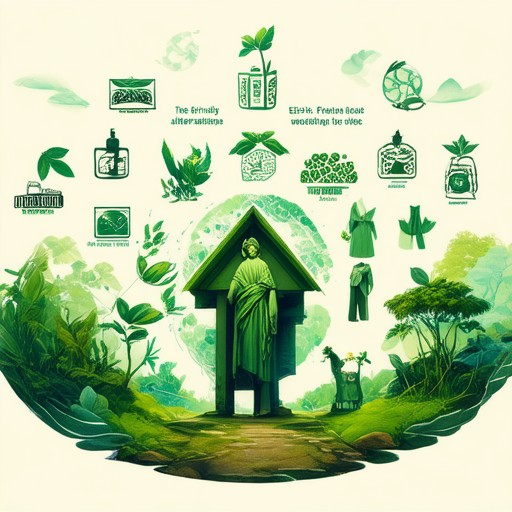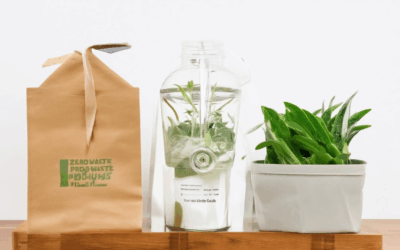Discover how easy it is to embrace a greener lifestyle with our curated collection of eco-friendly product alternatives. From household essentials to personal care items, we’ve got you covered with sustainable options that are both practical and impactful. Whether you’re looking to reduce your carbon footprint, save money, or simply make ethical choices, these eco-friendly alternatives offer a fresh perspective on everyday products. Explore top picks across various categories, learn about the benefits of sustainable materials, and find out how you can make small changes that add up to a big difference. Join us as we dive into the world of eco-friendly solutions and uncover the easiest ways to incorporate sustainability into your life.
Key Takeaways
- Adopt Zero-Waste Strategies: Implement recycling, composting, and use reusable items like cloth bags and water bottles to reduce plastic consumption.
- Conserve Resources Efficiently: Utilize water-saving devices and energy-efficient appliances to lower your carbon footprint.
- Choose Sustainable Transportation: Opt for electric vehicles, bicycles, or public transportation to reduce greenhouse gas emissions.
- Shift to Plant-Based Diets: Adopt a sustainable diet with minimal meat intake, buy organic produce, and reduce food waste through mindful meal planning.
- Support Ethical Fashion: Shop for second-hand items, choose clothing made from sustainable materials like organic cotton, and repair garments instead of discarding them.
- Make Green Home Improvements: Install energy-efficient windows, use low-VOC paint, and insulate your home to enhance sustainability.
- Select Certified Brands: Look for products certified as Fair Trade or USDA Organic to support eco-conscious businesses.
- Engage in Advocacy Efforts: Participate in environmental campaigns and petitions to drive policy changes and promote sustainability.
- Prioritize Mental Well-being: Spend time outdoors to connect with nature, fostering a deeper appreciation for environmental stewardship.
- Leverage Generation Z’s Commitment: Tap into the eco-friendly habits of Gen Z, who prioritize sustainability and responsible consumerism, to inspire collective action.

Are There Eco-Friendly Alternatives?
Yes, there are numerous eco-friendly alternatives that can help reduce your environmental impact. Here are some practical ways to make sustainable choices:
Eco-Friendly Cleaning Products
- Make your own natural cleaning solutions using ingredients like vinegar, baking soda, and essential oils. These alternatives are safe for the environment and reduce reliance on plastic bottles.
- Choose biodegradable detergents and laundry detergents that are free from harsh chemicals.
Reducing Waste
- Opt for reusable products such as cloth napkins, water bottles, and shopping bags to minimize single-use waste.
- Participate in recycling programs and compost organic waste to reduce landfill contributions.
Sustainable Energy Use
- Install solar panels or consider switching to renewable energy sources to power your home sustainably.
- Use energy-efficient appliances and technologies to lower your carbon footprint.
Healthy Eating Habits
- Incorporate plant-based meals into your diet to reduce meat consumption and lower your ecological footprint.
- Buy locally-grown and seasonal produce to minimize transportation emissions and support sustainable farming practices.
Reduction of Food Waste
- Plan meals carefully to avoid food wastage and utilize leftover ingredients creatively.
- Store food properly to extend its shelf life and reduce spoilage.
Eco-Friendly Transportation
- Use public transportation, bike, or walk whenever possible to decrease greenhouse gas emissions.
- Consider carpooling or purchasing an electric vehicle for reduced fuel consumption.
Support Sustainable Brands
- Purchase products from companies that use ethical and sustainable practices, such as eco-friendly clothing or fair-trade goods.
- Look for certifications like Fair Trade or Rainforest Alliance to identify responsible brands.
Conservation of Resources
- Fix leaks in pipes and faucets to conserve water and reduce energy usage for heating water.
- Install water-saving fixtures and aerators to minimize unnecessary water waste.
By adopting these eco-friendly alternatives, you can contribute positively to the environment while promoting sustainable living practices. Remember, every small step matters in creating a healthier planet for future generations.
Examples of Eco-Friendly Products
Eco-friendly products are items that minimize harm to the environment while providing functionality. Here are some popular examples:
- Reusable Shopping Bags : These replace single-use plastic bags, reducing plastic waste.
- Stainless Steel Water Bottles : Durable and reusable, they reduce the need for disposable plastic bottles.
- Bamboo Toothbrushes : Biodegradable and sustainable alternative to traditional toothbrushes.
- Compostable Food Wraps : Made from plant-based materials, they break down naturally and reduce plastic use.
- Organic Cotton Clothing : Grown without synthetic chemicals, it’s better for both people and the planet.
- Refillable Skincare Containers : Reduces waste from throwaway packaging by using recyclable containers.
- Glass Food Storage Containers : Reusable and free from BPA, they’re perfect for storing leftovers or snacks.
- Biodegradable Sponges : Made from natural fibers, they decompose quickly and are safer for the environment.
- Non-Toxic Cleaning Supplies : Safer alternatives to harsh chemicals, minimizing exposure to harmful substances.
- Solar-Powered Chargers : Charge devices using sunlight, reducing reliance on fossil fuels.
- E-Readers with Paperless Options : Supports digital reading and reduces paper consumption.
- Recycled Plastic Products : Items made from recycled materials, helping to reduce plastic pollution.
- Bicycle Sharing Programs : Promotes eco-friendly transportation by offering shared bikes around town.
- Car Pooling Services : Encourages sharing rides to reduce carbon emissions from vehicle usage.
These products not only help protect the environment but also encourage sustainable lifestyles. By choosing eco-friendly options, we can contribute to a healthier planet for future generations.
For more ideas and to learn how to incorporate these products into your daily life, visit our sustainable living guide .

What Can I Use Instead of “Sustainable”?
Eco Planeta Verde encourages a holistic approach to living in harmony with the environment. Here are some alternative terms and phrases that capture the essence of sustainability:
- Eco-friendly : Implies practices that minimize harm to the environment.
- Green : Refers to actions that promote environmental health and sustainability.
- Environmentally Friendly : Describes methods that have minimal negative impacts on the planet.
- Responsible : Suggests ethical and sustainable decision-making.
- Long-Lasting : Indicates durability and reduced resource consumption over time.
- Balanced : Pertaining to equilibrium in ecosystems and human activities.
- Conservationist : While primarily a noun, it can describe practices aligned with sustainability.
- Timeless : Relates to enduring principles that benefit future generations.
- Eco-Conscious Living : A phrase emphasizing awareness and responsibility towards the environment.
- Green Living : Encompasses sustainable daily habits and lifestyle choices.
- Responsible Living : Involves making decisions that positively impact both personal and planetary well-being.
- Non-Polluting : Specifically targets reducing harmful emissions and waste.
- Caring for the Earth : Highlights the human role in nurturing and preserving the environment.
For more insights into these concepts and how they apply to your life, visit our sustainable living guide . Explore practical tips and discover how small changes can make a big difference for future generations.

How Can I Be 100% Eco-Friendly?
To achieve a more eco-friendly lifestyle, consider implementing the following comprehensive strategies:
- Reduce Waste : Practice recycling and composting to minimize landfill contributions. Use reusable items like cloth bags and water bottles to decrease plastic consumption.
- Conserve Water : Install water-saving devices, such as low-flow fixtures. Avoid excessive lawn watering and utilize greywater systems for non-drinking purposes.
- Lower Energy Use : Transition to renewable energy sources like solar panels, supported by available grants. Opt for energy-efficient appliances and LEDs, and manage electricity use by closing blinds during the day.
- Sustainable Transportation : Consider an electric vehicle, bike, or public transportation. Carpool and limit flying to essential trips.
- Eco-Friendly Diet : Adopt a plant-based diet with minimal meat intake. Buy locally-sourced, organic produce and reduce food waste through careful meal planning.
- Sustainable Fashion : Choose second-hand, thrifting, or clothing made from sustainable materials like organic cotton or recycled polyester. Repair garments instead of discarding them.
- Green Home Improvements : Insulate your home, install energy-efficient windows, and use low-VOC products to enhance indoor air quality.
- Support Sustainable Brands : Look for certifications like Fair Trade and USDA Organic to identify eco-conscious businesses and vote with your purchases.
- Advocate for Environmental Policies : Engage in campaigns and petitions to support stronger environmental regulations and promote sustainability initiatives.
- Prioritize Mental Health : Spend time outdoors to connect with nature, fostering a deeper appreciation for environmental stewardship and motivation for eco-friendly actions.
By integrating these strategies, you can significantly reduce your ecological footprint and contribute to a healthier planet.
What Age Group Is the Most Eco-Friendly?
Generation Z, typically born after 1997, is often recognized as the most environmentally conscious and sustainability-driven generation. Research indicates that 80% of Gen Z consumers prefer purchasing from brands that prioritize sustainability, according to Porch Group Media (2024). This generation is actively engaged in advocating for eco-friendly practices and holds businesses accountable for ethical and sustainable operations.
- Eco-Friendly Practices: Gen Z is known for reducing waste, supporting sustainable products, and adopting green lifestyles. They frequently engage in activities like recycling, using public transportation, and supporting local businesses that align with their values.
- Sustainable Consumption: Many Gen Z individuals prioritize brands that commit to sustainability, reflecting their belief in responsible consumerism. This trend has led to a significant shift in market demand for eco-friendly products.
- Environmental Advocacy: They are vocal advocates for environmental causes and often participate in campaigns aimed at raising awareness about climate change and sustainability issues.
Eco Planeta Verde supports this generation’s efforts by providing valuable resources and tips for sustainable living. Our platform offers guides on reducing waste, discovering sustainable products, and adopting eco-friendly habits to contribute to a healthier planet. By working together, we can inspire more individuals to take proactive steps toward sustainability.
For more information on how you can join the movement and learn about sustainable living, visit our sustainable living section . Explore our blog for insightful articles and practical advice on making a positive environmental impact.

Is Bleach Bad for the Environment?
Bleach, particularly sodium hypochlorite, is widely used for its strong cleaning and disinfecting properties. While it serves many household purposes effectively, its impact on the environment cannot be overlooked.
Beneficial Uses
Bleach is highly effective at breaking down organic matter, making it a valuable tool for cleaning and sanitizing. Its ability to kill bacteria and viruses makes it essential in healthcare settings and water treatment facilities.
Environmental Impact
When not used properly, bleach can release toxic chemicals into the environment. Excess bleach can harm aquatic life, disrupt ecosystems, and contaminate soil and water supplies. Improper disposal of bleach can lead to hazardous waste situations.
Proper Disposal
To minimize environmental harm, always follow safety guidelines for bleach disposal. Do not pour unused bleach down drains or into sewers. Instead, consult local waste management services for safe disposal methods.
Alternatives
For everyday cleaning tasks, consider safer alternatives like vinegar, hydrogen peroxide, or baking soda. These options are less harsh on the environment and can be just as effective.
Regulations and Best Practices
Many governments have implemented regulations to control the production and use of bleach. Adhering to these guidelines helps reduce environmental risks associated with bleach usage.
Conclusion
Bleach has its benefits, but its environmental footprint should not be ignored. By using it responsibly and exploring eco-friendly alternatives, we can minimize its impact on the planet while still achieving our cleaning goals.
For more information on sustainable living and eco-friendly practices, visit Eco Planeta Verde .




0 Comments